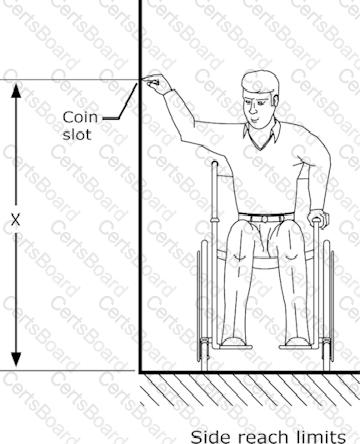In new construction, what is the percentage of pay phones that must be equipped with volume controls?
When designing an underground conduit system, a single bend should be NO MORE THAN ________ degrees.
For a cost estimate, an ICT distribution designer should produce a document listing each task with a cost placed beside them. The type of document used is a
Exhibit:

A pay telephone using coins needs to be installed in a public area. In the specifications, it is required that the telephone shall meet the ADA (Americans with Disability Act) requirement for side reach using a wheelchair. What will be the maximum reachable height or the value of "X"?
A program is in its execution phase when a component project manager suggests a potential change that could increase the financial benefit of the program. The program manager is hesitant to submit a change request, as it would extend the program schedule and require a scope change.
To whom should the change request be presented?
In which of the following design phases does the ICT distribution designer perform coordination with stakeholders and other disciplines (e.g.. mechanical, architectural, electrical) to ensure that the design is constructive and that any conflicts are resolved early in the process?
A hotel chain initiates a program to expand meeting offerings to include telecommunications technology and virtual meetings. The program has component projects, each of which requires team members to have different technical skills and expertise. The program manager assembles a team of project managers to lead each of the projects, and learns that the desired resources will not be available at the start of the program
As a result, the program manager must do which of the following'?
Before working on equipment, what is the FINAL step in the lockout/tagout (LOTO) procedure?
A program manager is working on benefits. The program team created and updated a benefits register earlier in the program. The benefits register should include which of the following?
A program manager is concerned that a program will be unable to achieve its intended benefits. How should the program manager handle this concern?


